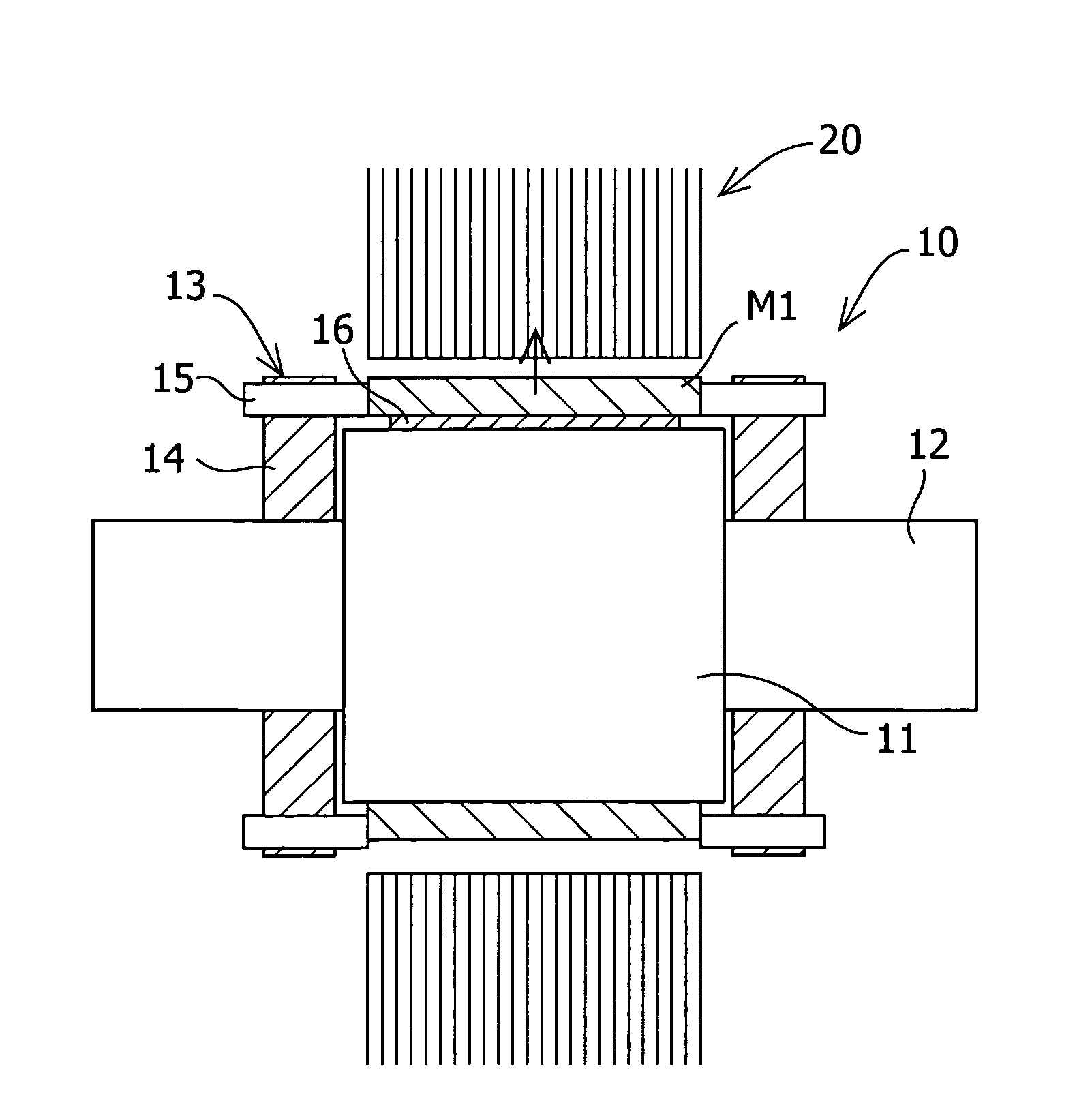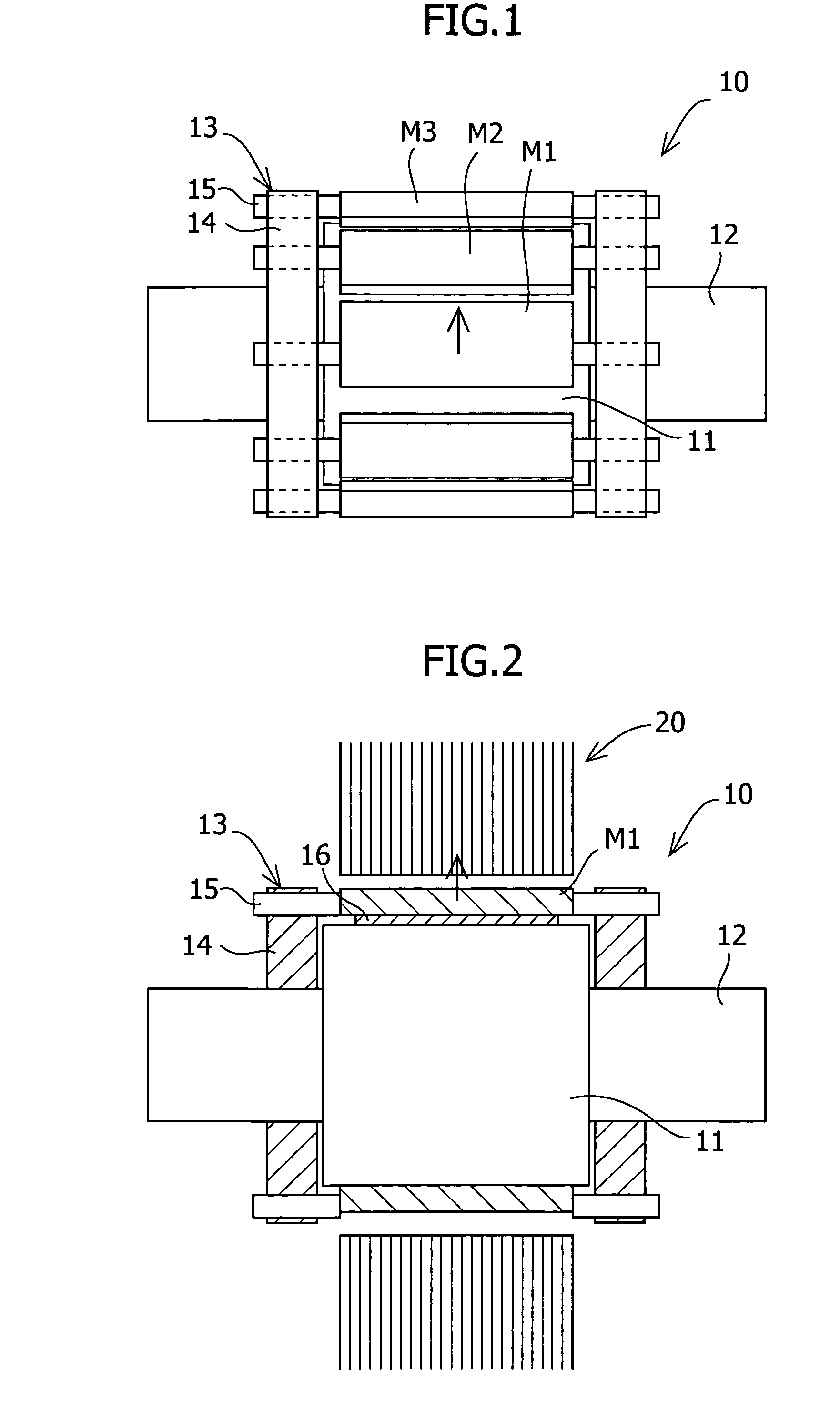Permanent magnet motor with magnets in an adjusted position to reduce cogging torque
a permanent magnet, torque-reducing technology, applied in the direction of magnetic circuit rotating parts, magnetic circuit shape/form/construction, stator/rotor body manufacturing, etc., can solve the problems of torque not being generated, hysteresis loss of stator yoke, duodenary, and thirty-sixth order components, which are attributed to permanent magnets, etc., to reduce cogging torque, high accuracy, and low vibration
- Summary
- Abstract
- Description
- Claims
- Application Information
AI Technical Summary
Benefits of technology
Problems solved by technology
Method used
Image
Examples
working example 1
[0082]A permanent magnet motor according to Working Example 1 had the same configuration as the permanent magnet motor according to Comparative Example 2 described above, except for items particularly described below, such as the position of the permanent magnets and the magnet holding member (see FIG. 11). It should be noted that a shaft runs through the center of the rotor yoke made of a low carbon steel, the shaft being made of the same material. In Working Example 1, the permanent magnets were held by the magnet holding member after a permanent magnet was moved in the circumferential direction, as shown in FIG. 1. Here, as the magnet holding member, magnet holding yokes having tap holes and hexagon socket set screws serving as the magnet holders were used. Moreover, the stator yoke was made by the rotational laminating method.
[0083]First, the amount of change in the cogging torque was measured when the permanent magnet was moved in the circumferential direction. More specificall...
working example 2
[0090]Working Example 2 was the same as Working Example 1 except that the permanent magnet was moved in the radial direction as shown in FIG. 2. First, the amount of change in the cogging torque when the permanent magnet was moved in the radial direction was measured. Non-magnetic SUS was used for the non-magnetic shim. More specifically, the amount of change in the cogging torque that occurred when the magnet M1 in FIG. 11 was moved in the radial direction was measured, and as in the above-described comparative example, the components of the cogging torque that changed were analyzed using Fourier analysis. FIG. 9 shows the results of the Fourier analysis in which the waveform of the amount of change in the cogging torque when the permanent magnet was moved in the radial direction was divided into components of respective orders of the waveform. As in the case where the permanent magnet was moved in the circumferential direction, the components of the cogging torque that changed wer...
working example 3
[0092]Working Example 3 was the same as Working Example 1 except that the permanent magnet was moved in the axial direction as shown in FIG. 3. First, the amount of change in the cogging torque when the permanent magnet was moved in the axial direction was measured. More specifically, the amount of change in the cogging torque that occurred when the magnet M1 shown in FIG. 11 was moved in the axial direction was measured, and the components of the cogging torque that changed were analyzed using Fourier analysis. FIG. 10 shows the results of the Fourier analysis in which the waveform of the amount of change in the cogging torque when the permanent magnet was moved in the axial direction was divided into components of respective orders of the waveform. As in the cases where the permanent magnet was moved in the circumferential direction or in the radial direction, almost all of the components of the cogging torque were of duodenary order. Moreover, the amount of change in the cogging ...
PUM
| Property | Measurement | Unit |
|---|---|---|
| residual magnetic flux density | aaaaa | aaaaa |
| length | aaaaa | aaaaa |
| length | aaaaa | aaaaa |
Abstract
Description
Claims
Application Information
 Login to View More
Login to View More - R&D
- Intellectual Property
- Life Sciences
- Materials
- Tech Scout
- Unparalleled Data Quality
- Higher Quality Content
- 60% Fewer Hallucinations
Browse by: Latest US Patents, China's latest patents, Technical Efficacy Thesaurus, Application Domain, Technology Topic, Popular Technical Reports.
© 2025 PatSnap. All rights reserved.Legal|Privacy policy|Modern Slavery Act Transparency Statement|Sitemap|About US| Contact US: help@patsnap.com



